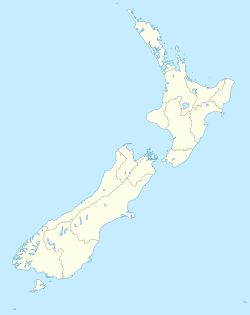Elizabeth Island (New Zealand) facts for kids
|
Pōkaikōkō
|
|
|---|---|

Elizabeth Island in front of tall mountains of Doubtful Sound
|
|
| Geography | |
| Location | Doubtful Sound |
| Coordinates | 45°25′0″S 167°7′15″E / 45.41667°S 167.12083°E |
| Area | 0.6 km2 (0.23 sq mi) |
| Length | 2.6 km (1.62 mi) |
| Width | 0.4 km (0.25 mi) |
| Highest elevation | 117 m (384 ft) |
| Administration | |
| Demographics | |
| Population | 0 |
Elizabeth Island, known in Māori as Pōkaikōkō, is the largest island found deep inside Doubtful Sound. This amazing place is located within Fiordland National Park on New Zealand's South Island. The island was formed a very long time ago during the last ice age. It has a long, narrow shape that lines up perfectly with the fiord itself. No people live on Elizabeth Island, and it is completely covered in thick, natural forest.
Contents
What is Elizabeth Island?
Elizabeth Island is a beautiful, untouched island in one of New Zealand's most famous fiords, Doubtful Sound. A fiord is a long, narrow inlet of the sea, often with steep cliffs on either side, created by glaciers. The island is about 2.6 kilometers (1.6 miles) long and 0.4 kilometers (0.25 miles) wide. It reaches a height of 117 meters (384 feet) above sea level.
How Was Elizabeth Island Formed?
The island's unique shape and location are thanks to something called glaciation. This means it was carved out by huge sheets of ice, or glaciers, during the last Ice Age. As the glaciers moved, they shaped the land, leaving behind this long island in the middle of the fiord.
Who Named Elizabeth Island?
The island got its name from Captain John Grono. He named it after his ship, a brig called Elizabeth. This happened sometime in late 1822 or early 1823.
Protecting the Waters: Taipari Roa Marine Reserve
The waters all around Elizabeth Island are very special. They are protected as part of the Taipari Roa (Elizabeth Island) Marine Reserve. A marine reserve is like a national park, but for the ocean! It helps to protect the sea creatures and their homes.
What Lives Around the Island?
The western side of Elizabeth Island faces the main flow of Doubtful Sound. Here, you can find amazing rock walls that are home to many different sea animals. Off the southern tip of the island, there are deep beds of kelp, which are large seaweeds that grow like underwater forests.
To the east of Elizabeth Island, there's a shallow channel where the water flows quickly. This area includes Olphert Cove and the mouth of the Elizabeth River. This part of the reserve is also famous for its beautiful black and red corals. These corals are very important and delicate parts of the underwater world.


